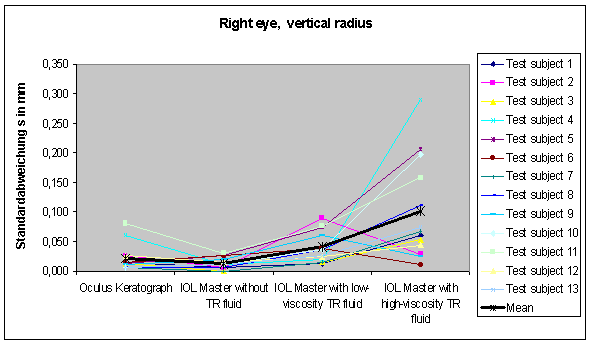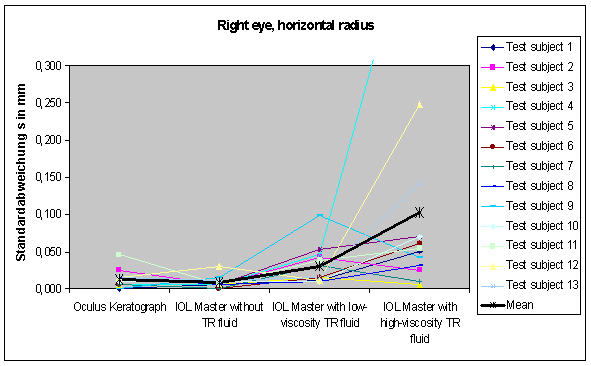|
Abstract |
|
(A long version is available here as pdf-file.) |
A study of the effect of the tear film on keratometric measurements with the IOL Master™
Nowadays, the axial length can be measured very accurately by optical biometry, so that deviations from the target refraction caused by errors in the measurement of the axial length are no greater
than approximately 0.1 D. Therefore, in considering the measurement of corneal radii with the IOLMaster™, the focus of attention has now shifted to the accuracy with which the corneal radii (or
refractive power of the cornea) themselves are determined. This study was undertaken to determine the effect of measuring deviations caused by the tear film.
A deviation in the radius measurement of 20 µm leads, in typical eyes, to a deviation from the target refraction of 0.1 dpt.
Since the clients for intraocular lens implants frequently have dry eyes, we examined whether administering tear replacement fluid improved the accuracy and reproducibility of keratometric
measurements.
To minimize error, the IOLMaster with software version V3.01 has algorithms intended to prevent measuring inaccuracies due to additional reflexes (caused by tear film problems) and imprecise images
of the test target (caused by eyelashes or eyelids).
The standard deviations of the corneal radii measured were presented in graphs (the abstract only shows the graphs for the right eye)
The y axis of each graph plots the standard deviation s , the x axis the various tests conducted in this study. Each graph contains 14 curves, one for each of the 13 test subjects and one for the
mean standard deviation.
The measurements using the Oculus keratograph serve for comparison with the IOLMaster™ in measuring the central corneal radii without the administration of tear replacement fluid. The graphs
show that the standard deviation in this test is of the same order of magnitude for both instruments, with the mean actually slightly less using the IOLMaster™. Comparing the measurements with
the IOLMaster™ with or without tear replacement fluid, we find that the standard deviation increases when the low-viscosity tear replacement fluid is administered.
The subjective impression was that the measurements of the central corneal radii using the IOLMaster™ without tear replacement fluid were most accurate and required the least time. Both types
of tear replacement fluid caused more or less significant reflexes at the 6 measuring points on the cornea and the points appeared blurred and distorted at times. This made measurement more complex
and difficult.
Conclusion
In accordance with the values we obtained, we recommend performing the measurements without administering a tear replacement fluid in normally healthy eyes.
Because of the small number of test subjects, who in addition were young people without pathologically dry eyes, this study can only indicate a trend.
|
|
|
Kristina Sander, Jena College of Applied Sciences, Faculty of Ophthalmic Optics; |

Graph 1:
Standard deviation in measurements of the right eye, vertical radius with and without tear replacement

Graph 2:
Standard deviation in measurements of the right eye, horizontal radius with and without tear replacement